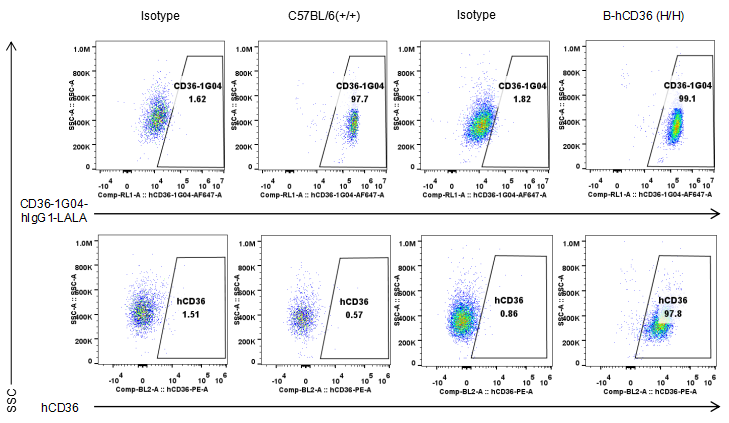| Strain Name |
C57BL/6-Cd36tm1(CD36)Bcgen/Bcgen
|
Common Name | B-hCD36 mice |
| Background | C57BL/6 | Catalog number | 111045 |
|
Related Genes |
CD36 (cluster of differentiation 36) | ||
|
NCBI Gene ID |
12491 | ||
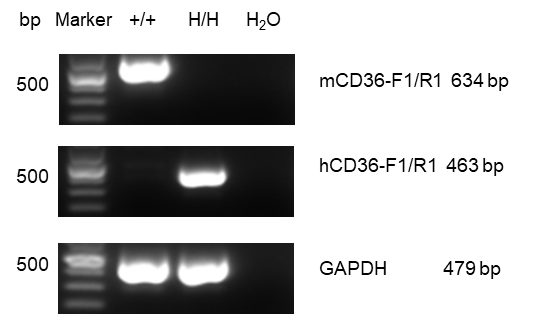
Strain specific analysis of CD36 gene expression in wild-type mice and B-hCD36 mice by RT-PCR. Mouse CD36 mRNA was detectable in lung of wild-type mice (+/+). Human CD36 mRNA was detectable only in homozygous B-hCD36 but not in wild-type mice.
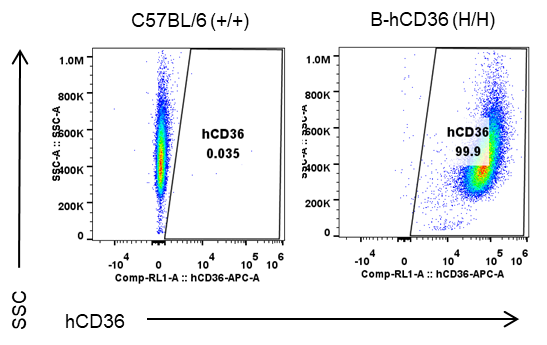
Strain specific CD36 expression analysis in homozygous B-hCD36 mice by flow cytometry. Peritoneal exudative macrophages were collected from wild-type mice (+/+) and homozygous B-hCD36 mice (H/H), and analyzed by flow cytometry with species-specific anti-CD36 antibody. Human CD36 was exclusively detectable in homozygous B-hCD36 but not in wild-type mice.
Analysis of leukocytes cell subpopulation in spleen

Analysis of spleen leukocyte subpopulations by FACS. Splenocytes were isolated from female C57BL/6 and B-hCD36 mice (n=3, 8-week-old). Flow cytometry analysis of the splenocytes was performed to assess leukocyte subpopulations. A. Representative FACS plots. Single live cells were gated for the CD45+ population and used for further analysis as indicated here. B. Results of FACS analysis. Percent of T cells, B cells, NK cells, dendritic cells, granulocytes, monocytes and macrophages in homozygous B-hCD36 mice were similar to those in the C57BL/6 mice, demonstrating that CD36 humanized does not change the overall development, differentiation or distribution of these cell types in spleen. Values are expressed as mean ± SEM.
Analysis of T cell subpopulation in spleen
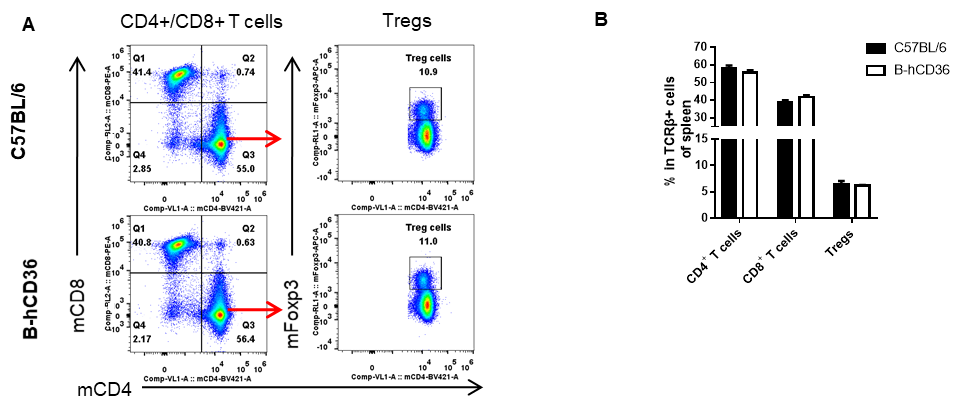
Analysis of spleen T cell subpopulations by FACS. Splenocytes were isolated from female C57BL/6 and B-hCD36 mice (n=3, 8-week-old). Flow cytometry analysis of the splenocytes was performed to assess leukocyte subpopulations. A. Representative FACS plots. Single live CD45+ cells were gated for TCRβ+ T cell population and used for further analysis as indicated here. B. Results of FACS analysis. The percent of CD4+ T cells, CD8+ T cells and Tregs in homozygous B-hCD36 mice were similar to those in the C57BL/6 mice, demonstrating that introduction of hCD36 in place of its mouse counterpart does not change the overall development, differentiation or distribution of these T cell subtypes in spleen. Values are expressed as mean ± SEM.
Analysis of leukocytes cell subpopulation in lymph node
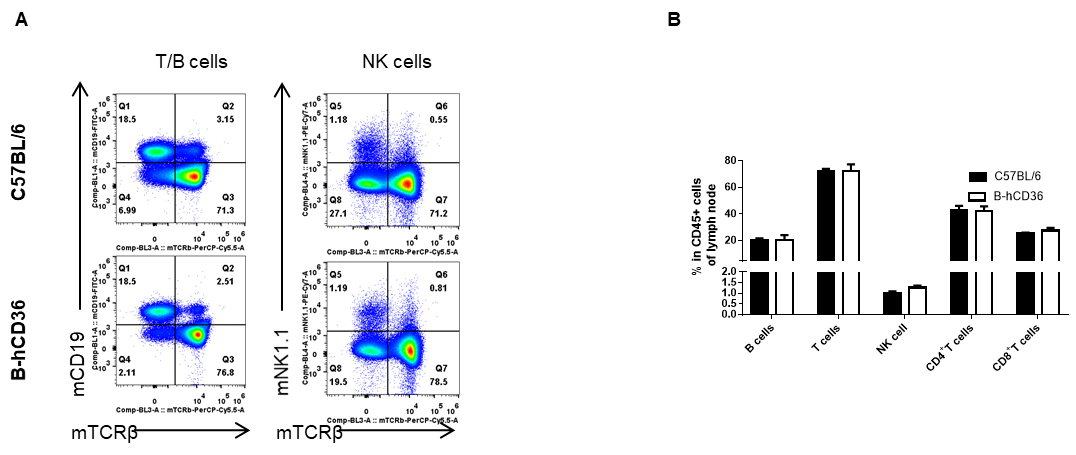
Analysis of lymph node leukocyte subpopulations by FACS. Lymph nodes were isolated from female C57BL/6 and B-hCD36 mice (n=3, 8-week-old). Flow cytometry analysis of the lymph nodes was performed to assess leukocyte subpopulations. A. Representative FACS plots. Single live cells were gated for the CD45+ population and used for further analysis as indicated here. B. Results of FACS analysis. Percent of T cells, B cells, and NK cells in homozygous B-hCD36 mice were similar to those in the C57BL/6 mice, demonstrating that CD36 humanized does not change the overall development, differentiation or distribution of these cell types in lymph node. Values are expressed as mean ± SEM.
Analysis of T cell subpopulation in lymph node
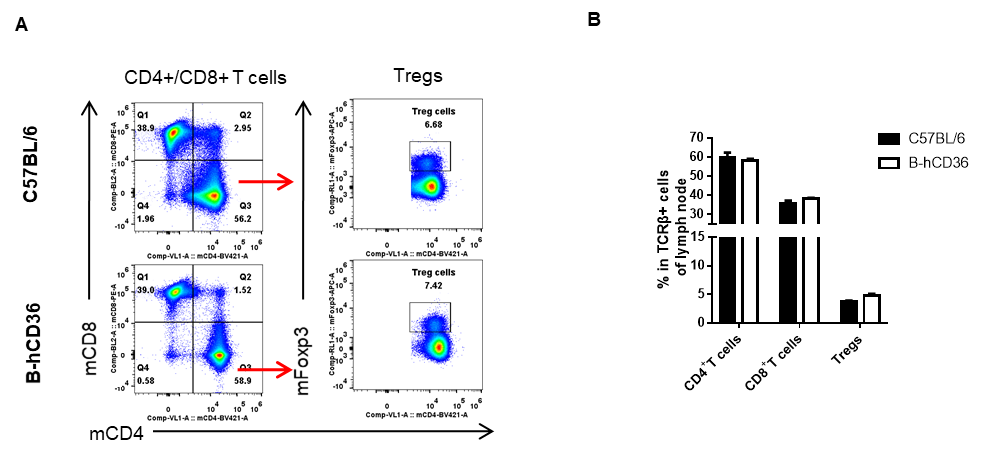
Analysis of lymph node T cell subpopulations by FACS. Lymph nodes were isolated from female C57BL/6 and B-hCD36 mice (n=3, 8-week-old). Flow cytometry analysis of the lymph node was performed to assess leukocyte subpopulations. A. Representative FACS plots. Single live CD45+ cells were gated for TCRβ+ T cell population and used for further analysis as indicated here. B. Results of FACS analysis. The percent of CD4+ T cells, CD8+ T cells and Tregs in homozygous B-hCD36 mice were similar to those in the C57BL/6 mice, demonstrating that introduction of hCD36 in place of its mouse counterpart does not change the overall development, differentiation or distribution of these T cell subtypes in lymph node. Values are expressed as mean ± SEM.
Analysis of leukocytes cell subpopulation in blood

Analysis of blood leukocyte subpopulations by FACS. Blood was isolated from female C57BL/6 and B-hCD36 mice (n=3, 8-week-old). Flow cytometry analysis of the blood was performed to assess leukocyte subpopulations. A. Representative FACS plots. Single live cells were gated for the CD45+ population and used for further analysis as indicated here. B. Results of FACS analysis. Percent of T cells, B cells, NK cells, dendritic cells, granulocytes, monocytes and macrophages in homozygous B-hCD36 mice were similar to those in the C57BL/6 mice, demonstrating that CD36 humanized does not change the overall development, differentiation or distribution of these cell types in blood. Values are expressed as mean ± SEM.
Analysis of T cell subpopulation in blood
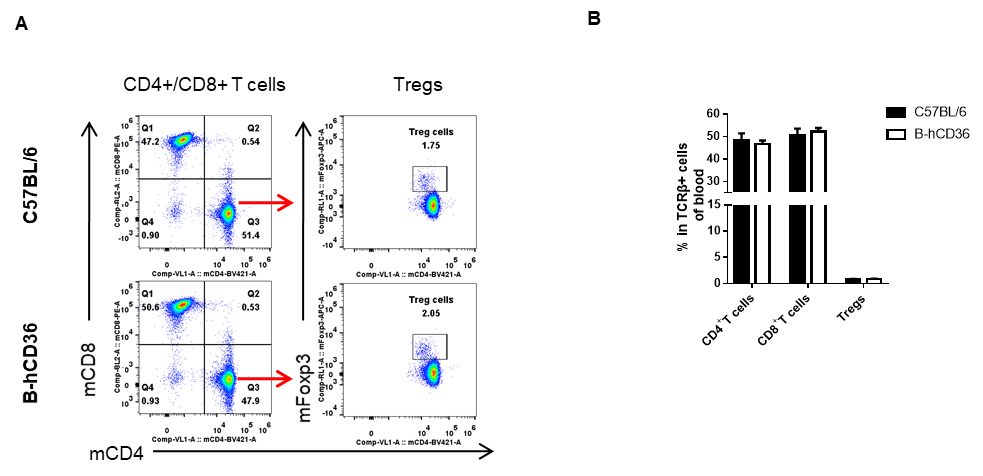
Analysis of blood T cell subpopulations by FACS. Blood was isolated from female C57BL/6 and B-hCD36 mice (n=3, 8-week-old). Flow cytometry analysis of the blood was performed to assess leukocyte subpopulations. A. Representative FACS plots. Single live CD45+ cells were gated for TCRβ+ T cell population and used for further analysis as indicated here. B. Results of FACS analysis. The percent of CD4+ T cells, CD8+ T cells and Tregs in homozygous B-hCD36 mice were similar to those in the C57BL/6 mice, demonstrating that introduction of hCD36 in place of its mouse counterpart does not change the overall development, differentiation or distribution of these T cell subtypes in blood. Values are expressed as mean ± SEM.
Antibody-binding assay to test B-hCD36 model using anti-CD36 antibody
